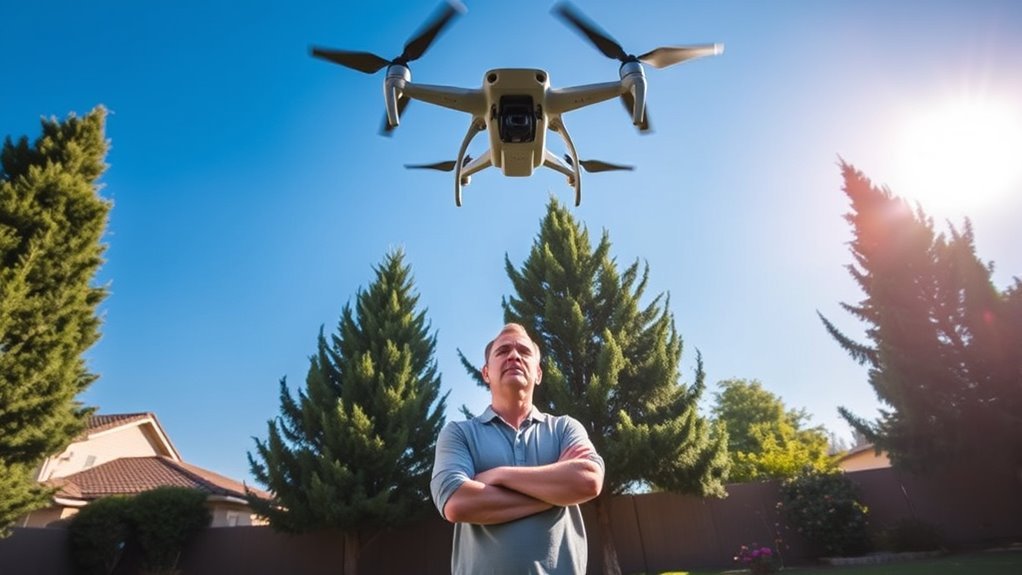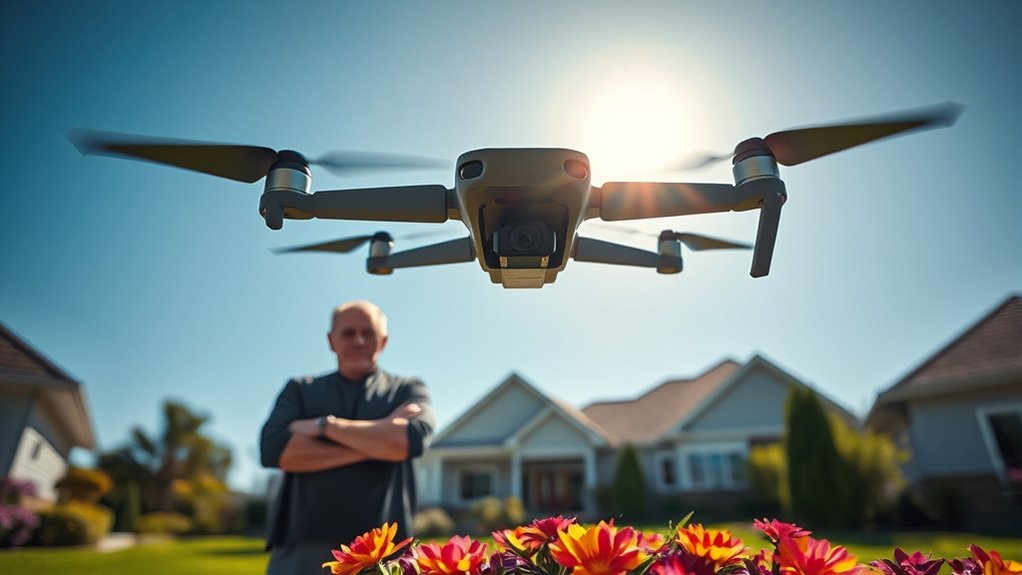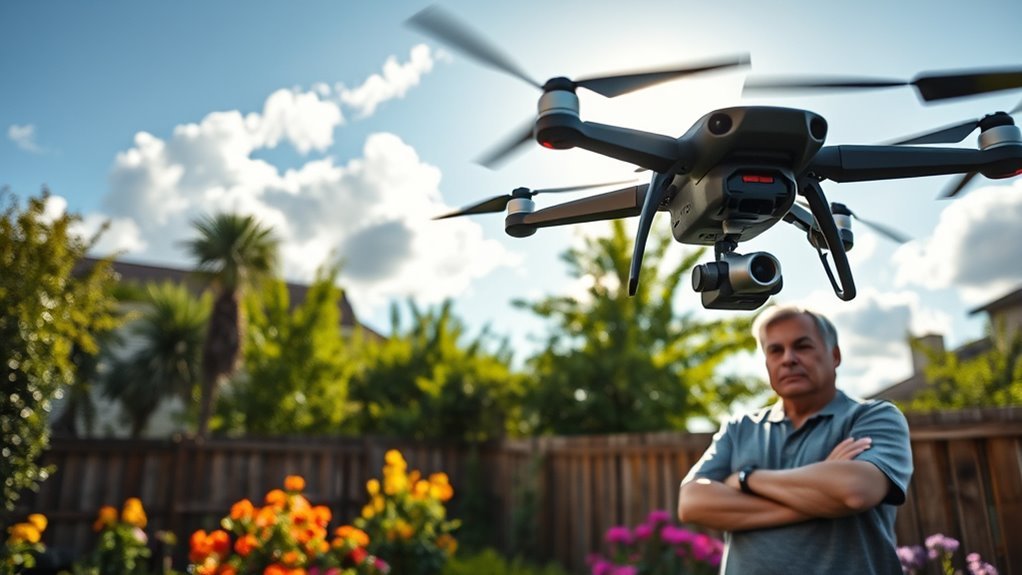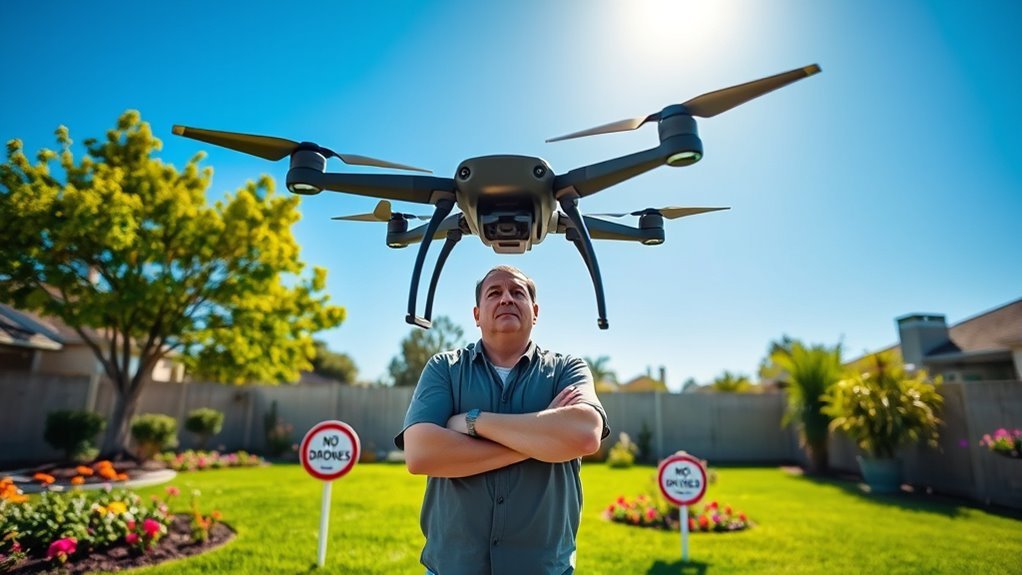To stop a drone hovering over your property, first, understand your rights—property owners have protections against intrusive surveillance. Identify the drone type and its purpose, as this can influence your response. Consider physical barriers like privacy fences or shrubbery to block visibility. Technology such as drone detection systems can also help. If needed, communicate calmly with the operator about your privacy concerns. If issues persist, reporting to local authorities or exploring legal options may be necessary. You’ll discover more strategies as you proceed.
Understanding Drone Regulations and Your Rights

Although drones have become increasingly popular for various recreational and commercial purposes, understanding the regulations governing their use is essential for protecting your rights as a property owner. Familiarizing yourself with drone laws is critical, as they can vary considerably by jurisdiction. Generally, you have the right to enjoy your property without intrusive surveillance or disturbances from drones. Many states have enacted laws that specifically address privacy concerns and property rights, allowing you to take action if a drone violates your space. When asserting your rights, it’s crucial to document any incidents and consult with legal professionals familiar with drone regulations. Knowing your rights empowers you to defend your property against unwanted drone activity effectively. Additionally, it’s important to be aware of no-fly zones where drone operations are prohibited, as this knowledge can further protect your property from unauthorized surveillance. Moreover, understanding the need to secure appropriate permits from the U.S. Forest Service before flying drones in certain areas can help ensure compliance with local and federal regulations.
Identifying the Drone Type and Its Purpose

Once you’re aware of your rights regarding drone activity, the next step is to identify the drone type and its purpose. Examine its drone features, such as size, shape, and design. Commercial drones often have more advanced technology, like cameras or sensors, indicating potential surveillance motives. In contrast, hobbyist drones might be smaller and less intrusive, typically used for recreational purposes. Understanding these usage motives can help you assess whether the drone poses a legitimate threat to your privacy. Pay attention to flight patterns; a drone hovering consistently may imply a specific intent, while erratic movements can suggest a malfunction or operator inexperience. Additionally, knowing about collision avoidance systems can provide insight into how the drone may react to obstacles while in flight. By identifying the drone type and purpose, you can better determine your next steps for addressing the situation. Additionally, being aware of signal attenuation can help you understand the limitations of the drone’s capabilities, particularly when it comes to detecting objects through walls or barriers.
Assessing the Situation Before Taking Action

Before you take any action against a hovering drone, it’s essential to assess the situation thoroughly. Start by identifying the drone type and determining its flight patterns to understand its behavior. Additionally, consider any privacy concerns that may arise from its presence to inform your next steps. For instance, knowing whether the drone is a professional inspections model like the Flyability Elios 3 can indicate its purpose and potential implications for your privacy. Drones like the Lucid Cleaning Drone are designed for specific tasks such as sanitation, which may affect your assessment of their presence.
Identify the Drone Type
Understanding the type of drone hovering over your property is essential for determining the appropriate response. Start by employing drone identification techniques, such as observing its size, color, and any markings. These factors can help you classify the drone using established drone classification systems, which typically categorize them into consumer, commercial, and military types. Each category has different capabilities and regulatory implications. For example, a consumer drone might be harmless, while a commercial drone could be conducting surveillance or delivering packages. Knowing the drone type enables you to assess potential threats to your privacy or safety and informs your next steps. By accurately identifying the drone, you can take informed action that aligns with your desire for freedom and privacy.
Determine Flight Patterns
How can you effectively assess the situation with a drone hovering over your property? The first step is to observe its flight patterns and understand its behavior. Drones can exhibit various behaviors based on their purpose, so identifying these patterns is essential.
| Observation | Analysis |
|---|---|
| Hovering in one spot | Potential surveillance |
| Repeated circles | Mapping or reconnaissance |
| Erratic movements | Possible malfunction or hobbyist |
Assess Privacy Concerns
While you may feel uneasy with a drone hovering over your property, it’s crucial to assess your privacy concerns objectively. Start by determining whether the drone’s presence constitutes a privacy invasion. Are you being surveilled? Consider the drone’s altitude, distance, and any visible cameras. If it’s capturing images or video of your private areas, you might have grounds to act. Familiarize yourself with local laws regarding drone surveillance; they vary greatly. Document the drone’s behavior and any potential violations to build a case if necessary. Ultimately, understanding your rights and the specifics of your situation will empower you to address the issue effectively while safeguarding your freedom and privacy.
Using Physical Barriers to Protect Your Privacy
Implementing physical barriers can markedly enhance your privacy and deter drones from hovering over your property. Privacy fences and noise barriers serve as effective solutions to create a protective boundary. These structures not only obstruct the line of sight but also minimize sound, making it harder for drones to detect activity within your space.
Here’s a helpful comparison of barrier options:
| Barrier Type | Benefits |
|---|---|
| Privacy Fences | Block view, enhance security |
| Noise Barriers | Reduce sound, deter detection |
| Shrubbery | Natural camouflage, aesthetic |
| Walls | Maximum coverage, durable |
Utilizing Technology to Detect and Neutralize Drones
To effectively manage drone activity over your property, you’ll want to contemplate advanced technology solutions. Drone detection systems can identify unauthorized drones, while signal jamming techniques disrupt their communication. Additionally, anti-drone technology solutions can neutralize threats, ensuring your privacy is protected. Implementing these solutions can also enhance organizational reliability by minimizing risks associated with unauthorized surveillance.
Drone Detection Systems
As drones become increasingly common, employing drone detection systems has become essential for property owners concerned about privacy and security. These systems utilize various drone detection methods to identify and track unauthorized drones in your airspace. By investing in advanced technology, you can enhance your privacy protection and deter intrusive surveillance.
| Detection Method | Description |
|---|---|
| Radar Systems | Detects drones using radio waves. |
| Acoustic Sensors | Listens for drone sounds to locate them. |
| Optical Cameras | Uses visual recognition to identify drones. |
Implementing these systems not only empowers you to protect your property but also supports your right to privacy in an increasingly monitored world. Stay informed, and choose the right detection method for your needs.
Signal Jamming Techniques
While drone detection systems help identify unauthorized drones, signal jamming techniques offer a proactive approach to neutralizing them. These methods create signal interference, disrupting the drone’s communication and navigation systems. By using devices that emit signals on the same frequency as the drone, you can effectively prevent it from receiving commands or relaying data back to its operator. However, it’s vital to reflect on the legal implications; many jurisdictions restrict or prohibit signal jamming due to potential interference with legitimate communications. Before implementing any jamming techniques, verify you fully understand the regulations in your area. Balancing your right to privacy with compliance is essential for effectively managing unauthorized drone activity.
Anti-Drone Technology Solutions
Given the increasing prevalence of unauthorized drones, implementing anti-drone technology solutions is essential for property owners concerned about privacy and security. You can utilize advanced drone security systems like radar and infrared sensors to detect drones before they invade your airspace. Additionally, some systems employ artificial intelligence to identify and classify these aerial intruders accurately.
As you explore your options, consider the implications of anti-drone legislation, which may dictate what technologies you can use. Effective solutions might also include signal jamming to disrupt drone communication or net capture systems to neutralize threats safely. By investing in these technologies, you can protect your property and assert your rights, ensuring your space remains free from unwanted surveillance.
Communicating With the Drone Operator
If you find a drone hovering over your property, reaching out to the operator can often resolve the situation quickly and amicably. Initiate drone communication by identifying the drone’s registration number or any visible contact information. Use a calm, respectful approach to facilitate operator engagement. Politely express your concerns about privacy or safety, and ask for their intentions regarding the drone’s presence. Most operators are reasonable and may not realize they’re infringing on your space. If you can establish a friendly dialogue, they might agree to move the drone away. Remember, direct communication can often lead to a satisfactory resolution without escalating the situation unnecessarily. Your willingness to engage can promote understanding and respect for your property rights.
Reporting Unwanted Drone Activity to Authorities
When you encounter a drone that won’t leave your property, it may be necessary to report the activity to local authorities. Start by familiarizing yourself with the specific reporting procedures in your area, as these can vary considerably. Document details such as the drone’s appearance, flight patterns, and any potential privacy violations. This information will be essential for authorities to assess the situation. Reach out to local law enforcement or regulatory agencies to file your report, providing them with all necessary details. Remember, your right to privacy and property must be respected, and local authorities are equipped to handle such nuisances. Taking action not only protects your space but also contributes to broader community safety and freedom from unwanted surveillance. Additionally, be aware that unauthorized flights over restricted zones can lead to serious legal consequences for the operator.
Exploring Legal Options for Persistent Issues
Persistent drone issues may require you to explore legal avenues if reporting to authorities doesn’t yield results. Understanding your property rights is vital in asserting control over unwanted drone activity. You might consider seeking legal remedies such as pursuing a nuisance claim, especially if the drone’s presence disrupts your enjoyment of your property. Additionally, reviewing local laws regarding airspace and privacy can provide insights into potential violations. Consulting with an attorney who specializes in property or aviation law can help clarify your options and strengthen your case. If necessary, you may also file a formal complaint with the Federal Aviation Administration (FAA) to address persistent violations. Taking these steps can empower you to protect your space effectively. Furthermore, it’s essential to recognize that federal laws regulate drone use to ensure safety and privacy in national airspace.
Frequently Asked Questions
Can I Shoot Down a Drone Hovering Over My Property?
Could you imagine defending your space only to face legal repercussions? You can’t just shoot down a drone; drone laws vary by state. Respect your property rights, but seek legal avenues for resolution instead.
What Should I Do if the Drone Captures Images of Me?
If a drone captures images of you, consider your privacy concerns seriously. Research legal options available in your jurisdiction, and document the incidents to support any potential claims or complaints regarding invasion of privacy.
Are There Apps to Block Drone Signals or Communication?
You might wonder if drone signal jammers exist, capable of creating communication interference. While some apps claim to disrupt signals, their legality varies, so always check your local laws before attempting any interference.
How Can I Identify the Drone Operator if They Are Nearby?
To identify a drone operator nearby, utilize drone identification techniques like visual observation and sound detection. Combine this with operator tracking methods, such as scanning for RF signals and using directional antennas, to locate them effectively.
What Are the Penalties for Drone Operators Violating Privacy Laws?
If drone operators violate privacy laws, they may face fines or even criminal charges, depending on the severity of the infringement. Understanding drone regulations is essential to protect your rights and maintain personal freedom.

